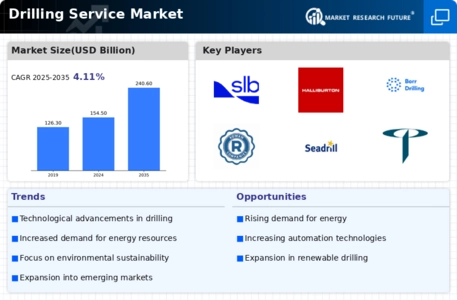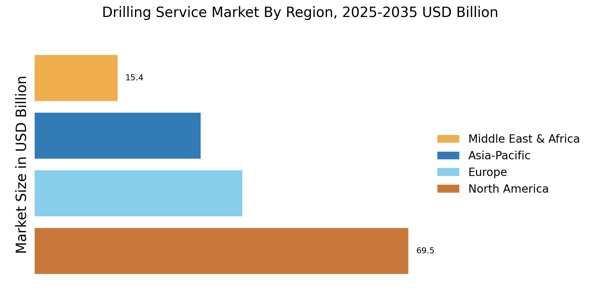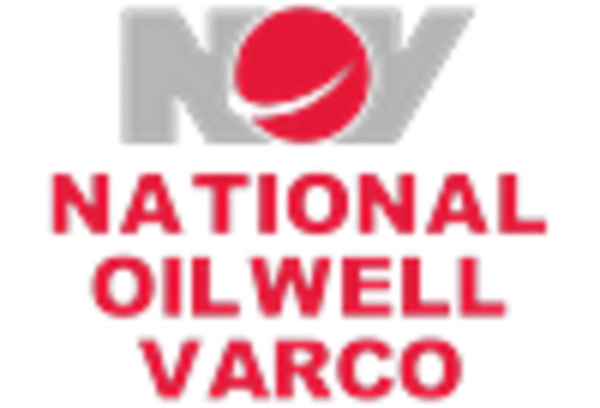Geopolitical Factors
Geopolitical dynamics have a profound impact on the Drilling Service Market, influencing exploration and production activities across various regions. Political stability, trade agreements, and international relations can either facilitate or hinder drilling operations. For instance, regions with abundant natural resources but unstable political climates may deter investment, while stable regions may attract significant capital for exploration. Recent trends indicate that countries are increasingly seeking energy independence, which can lead to heightened drilling activities in certain areas. Additionally, geopolitical tensions can disrupt supply chains, affecting the availability of drilling services. As nations navigate these complexities, the ability to adapt to geopolitical shifts will be crucial for drilling service providers aiming to maintain their market position and capitalize on emerging opportunities.
Regulatory Frameworks
The regulatory environment significantly influences the Drilling Service Market, as governments worldwide implement stricter regulations to ensure environmental protection and safety. Compliance with these regulations often necessitates the adoption of advanced drilling technologies and practices, which can increase operational costs but also enhance safety and efficiency. For example, regulations regarding emissions and waste management compel drilling companies to invest in cleaner technologies, thereby driving demand for innovative drilling services. Additionally, the regulatory landscape varies across regions, creating both challenges and opportunities for service providers. Companies that can navigate these complexities and adapt to changing regulations are likely to gain a competitive edge in the market. As the focus on environmental sustainability intensifies, the ability to comply with regulatory requirements will be a key driver of growth in the drilling service sector.
Increased Energy Demand
The Drilling Service Market is experiencing a surge in demand for energy resources, driven by the growing global population and industrialization. As economies expand, the need for oil and gas continues to rise, prompting exploration and production activities. According to recent data, energy consumption is projected to increase by approximately 30% by 2040, necessitating enhanced drilling services to meet this demand. This trend compels companies to invest in advanced drilling technologies and services to optimize resource extraction. Furthermore, the shift towards cleaner energy sources, while significant, still relies heavily on traditional fossil fuels in the short term, thereby sustaining the drilling service market. The interplay between traditional energy needs and the transition to renewables creates a complex landscape for drilling service providers, who must adapt to evolving market dynamics.
Technological Innovations
Technological advancements play a pivotal role in shaping the Drilling Service Market. Innovations such as automated drilling systems, real-time data analytics, and advanced drilling fluids have revolutionized the efficiency and safety of drilling operations. For instance, the implementation of automated drilling rigs has been shown to reduce operational costs by up to 20%, enhancing profitability for service providers. Moreover, the integration of data analytics allows for better decision-making and risk management, which is crucial in a market characterized by fluctuating oil prices. As companies strive to improve their operational efficiency, the demand for technologically advanced drilling services is likely to increase. This trend not only boosts productivity but also aligns with the industry's focus on sustainability, as more efficient drilling practices can lead to reduced environmental impact.
Investment in Renewable Energy
The transition towards renewable energy sources is reshaping the Drilling Service Market, as companies seek to diversify their portfolios and invest in sustainable practices. While traditional fossil fuel extraction remains vital, there is a growing recognition of the need to incorporate renewable energy projects into business strategies. Investments in geothermal energy, for instance, are gaining traction, as they require drilling expertise similar to that of oil and gas operations. This diversification not only mitigates risks associated with fluctuating oil prices but also aligns with global sustainability goals. As the energy landscape evolves, drilling service providers that can adapt to this shift and offer services in renewable sectors are likely to thrive. The interplay between traditional and renewable energy investments presents a unique opportunity for growth within the drilling service market.


















Leave a Comment